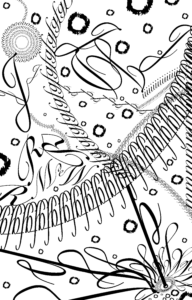For the first project, Rainee, Alan, and I decided to alter the human form by drawing inspiration from ocean creatures and specifically, a fish. There are so many elements of the deep sea that have yet to be explored by humans – oxygen tanks provided aren’t even enough to allow us to take a glimpse, and the technology we have at the moment isn’t strong enough to survive the pressure in the deep sea. So how do these various sea creatures survive? There is much mystery and fascination to the various habits of these creatures that humans cannot even begin to imagine. That is what Drowning, our project, attempts to do – bridge the gap between humans and fish to create an altered form of the human body using elements of biomimicry.
Though fish and humans are relatively different in terms of physical stature and composition, they share a few common traits: the need to eat, organs that keep us alive, and a spine – which is what we decided to draw on the most. To create the spine, we used a malleable wire that we bent into a net-like frame and layered it over an actual fishing net turned into the base of a dress, weaving an LED strip into an iridescent fabric to create dimension to it. We originally wanted to use optic fibres, but the LED light that we were going to use was not bright enough to light the entire fibres. We then connected the LED lights to Arduino in order to make it change colour according to the volume of music played.
Something we struggled with was getting the colour/brightness to vary according to how loud the music was. The analog input kept jumping and the sensor values were inaccurate. To fix this, Alan used three ranges in order to have better control of the brightness.
In order to improve our project for the future, we can figure out a way to embed the circuit into the wearable instead of connected separately. Furthermore, we can try to find a different sensor that reacts to distance better than the microphone sensor. Based off of feedback from the class, rather than focusing on one part of the body, we could try to find a way to transform the entire figure into a fish-human hybrid, and create even more exaggerated features to truly distort the wearer’s body.
Overall, I enjoyed creating this project and learned a lot from the process. Not only does Drowning attempt to create a fish-human hybrid, it also draws attention to the feeling of being trapped by beauty constructs. The fabric of the wearable is beautiful, but the net and the wire themselves are rather “ugly” and restraining. In a sense, it is an ironic allusion to humans restricting themselves by beauty standards and constructs – something that is only able to be felt by humans.





